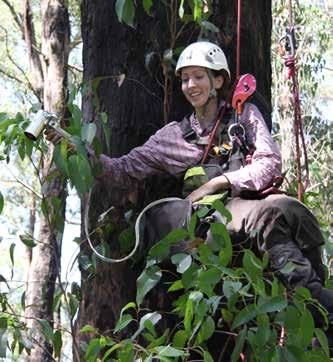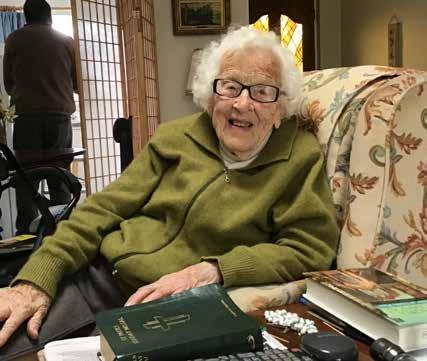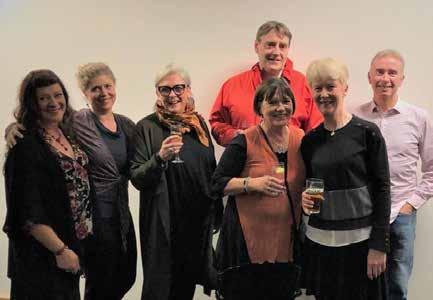
14 minute read
Staying in touch with our alumni
ANNE FOALE (nee Thomas) CLASS OF 1974
A passionate educator, Anne Foale has worked in Tasmanian schools and colleges for more than 40 years. A former teacher, librarian and Religious Education Coordinator, Anne was appointed Principal of St James Catholic College in 2007, a position she held for 10 years. Anne is an active member of the Australian Council of Educational Leaders and remains closely integrated with her hometown of Cygnet through her role as president of the Cygnet Folk Festival. She returned to her former SMC stomping ground in January, where she presented to the College Leadership Team on ‘strengths based leadership’, inspiring staff to be energised and authentic about the leadership opportunities and challenges facing them for 2020 – little did we know then just how challenging the year would be!
You attended the College for two years, from 1973 to 1974, after completing your primary and middle secondary schooling in your hometown of Cygnet (St James Convent School). What are your strongest memories of your time at St Mary’s? It was rather intimidating making the entrée into a cohort of girls who had well-established friendship groups and whose connections to SMC were already very strong, unlike mine. I did, however, have the advantage of having a brother who had preceded me to St Virgil’s College the previous year and made some connections which I was able to share, and they helped me find a place within the cohort. So overall, the ‘settling into a new school’ was relatively smooth and I did make some lovely friends and felt welcomed.
I was a studious girl and enjoyed school and learning, so I found the expanded horizons of a city school with so many more students invigorating. With the benefit of hindsight, I recognise that as I held my own academically and made Dux in 1974, the teaching I had at Cygnet put me in good stead for the transition, as of course did the unwavering support and sacrifice of my family.
What was your journey since graduating from St Mary’s College? Following graduation, I had a very brief foray into the Commonwealth Public Service just around the time of the Tasman Bridge collapse, but I quickly realised that I wanted to take up university study options and ended up spending the first two years of university life living in a university college [Ena Waite College, Hobart].
I loved my years at university and completed a Bachelor of Arts at the University of Tasmania, followed by a Graduate Diploma in Librarianship at the Tasmanian College of Education in Hobart. I taught for a few years as a teacher librarian in the Department of Education.
After the birth of my second child I took three years leave — during this time I set up a family-based childcare in my home under the auspice of the Kingborough Council, providing the first such option for the lower Channel area. I returned from leave and went back to full time work but this time with Catholic Education. I moved into secondary teaching at St James College and then held the position of Religious Education Coordinator for Sacred Heart College, New Town for 11 years, moved onto Deputy Principal at MacKillop College
Staying in touch with OUR ALUMNI
and then 10 years as Principal at St James Catholic College. During this time of establishing my career in education, I studied to complete a Graduate Diploma of Teaching [Religious Education] and a Master of Educational Leadership, both through Australian Catholic University.
I also managed the challenge of an 11-year battle with cancer – Hodgkin Lymphoma. I am eternally grateful for the support from my wonderful family through this battle, as well as the support I received from my St James College family and the Sacred Heart community.
You have also been instrumental on the Australian Council of Educational Leaders (ACEL) as past National Director and the Tasmanian President. Can you tell us more about your experience in these roles? I have been actively involved with ACEL for about 20 years – many of those years spent as a member of the local branch executive, six years
as National Director and seven as the Tasmanian Branch President. The breadth and depth of the organisation and its many opportunities for professional growth, networking and experiences have been critical in my overall formation as an educator.
I highly valued, and still do, its wide perspective on education and its precision and focus on leadership in particular. The opportunities to engage thoughtfully and critically with colleagues from all education sectors and at all levels from preschool to university and beyond have enriched the way I think, interact with colleagues and indeed lead.
Being able to work with and learn from some of the best educators in the country on the national board, and being able to have direct contact with some of the many internationally respected presenters and ACEL collaborators, has been such a lifegiving part of my career.
What advice would you give current students wanting to pursue a similar profession? My advice for all students, no matter what profession they aspire to, would be to follow what life is giving for you and commit with all your heart to a dream, if you have one. But if that does not ring true for you, then just keep an eagle eye for the doors that seem to be opening for you which may not be your current passion but which may take you to a place you couldn’t have dreamt of yourself.
SEEING DOUBLE — TWO GENERATIONS OF SMC GIRLS
History is repeating itself for the second time in more than 30 years for two St Mary’s College families.
This year, the Lovell and Shea families both enrolled their second-generation daughters at the College.
We look forward to seeing the girls follow in the footsteps of their mothers and continue their family’s long and proud legacy at SMC! Above: Alumni Alison Lovell (nee Harvey), left, and Brigid Shea (nee Noonan) pictured starting Prep circa 1986; their daughters Madeleine Lovell, left, and Beatrice Shea on their first day of Prep and Kindergarten respectively.
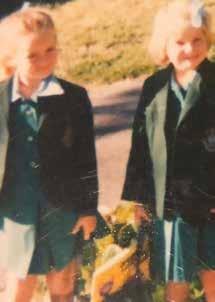
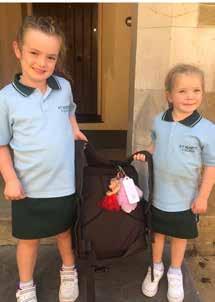
Staying in touch with OUR ALUMNI
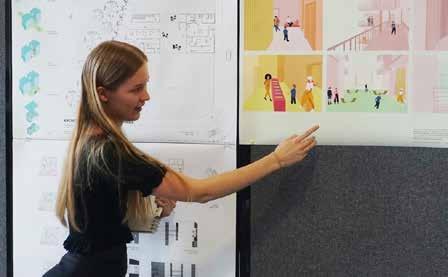
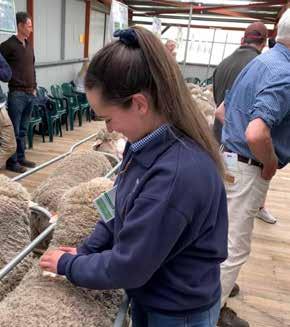
IMOGEN BARRY-MURPHY CLASS OF 2018
What started with a simple enquiry at a University of Tasmania careers evening for Year 12 students in 2018 has developed into an interstate university scholarship for Imogen Barry-Murphy. Representing Tasmania well, Imogen received a Bond University Excellence Scholarship and is studying a two-year accelerated Bachelor of Architecture Studies. Now halfway through her degree, Imogen is making her mark on the future of architecture by achieving top of the class for Design Communications, earning her an invitation to the Executive Dean’s Awards.
What are you currently studying and at which university? I received a Bond University Excellence Scholarship and am studying a Bachelor of Architectural Studies, a two-year accelerated degree. It all happened very fast. I received my scholarship offer at Christmas time in 2018 and had to make a quick decision on whether I’d attend or not. I officially locked it in on 1 January 2019 and had to prepare to move interstate quickly. Why did you choose this pathway? At the start of Year 7 I heard about the Housing and Design class and was intrigued. I was in Year 10 when I elected to study this. I planned ahead and looked at related classes, also completing Graphic Design in Year 9-12 and Housing and Design in Year 12.
What do you hope to achieve in the future? Once I graduate, I hope to receive an internship to work within one of the Australian industries. I would like to focus on small housing design and simple, affordable housing based on the climates.
How did St Mary’s College help you and your learning endeavours? Ken Lachlan was a fantastic teacher in Year 12 who opened my eyes to studying architecture. He spoke about the different elements and provided a greater understanding of how the university course would work, which equipped me well for my university journey.Tameika Grist and Wendy Forsyth encouraged me to apply for the scholarship and helped with the application, offering wonderful support. What did you most like about St Mary’s College? I liked that it felt like a small, comfortable environment, where I was able to build my confidence. The learning path I had helped me discover what I was passionate about. Without those teachers and classes I wouldn’t have found it. LUCY COOPER CLASS OF 2012
Lucy Cooper’s workday is a little different to that of most people. From the crack of dawn, you’ll find her on a farm somewhere in rural Tasmania. This is where the first female wool buyer in the state with a traineeship with Roberts Rural Co is making leaps and bounds in Tasmania’s wool selling landscape. Tell us about your current work endeavours and what they entail? I am a trainee Sheep and Wool Advisor with Roberts Rural Co. I work with owners state-wide to discuss and outline the benefits of their wool and navigate the best price for the wool export sales. I’m also supporting the livestock assessments and wellbeing while analysing how their environment and living impacts the wool and am lucky to be shadowing existing wool and sheep advisors. I’m passionate about getting more young people and women involved in the agriculture sector. What does a typical day look like for you? In a day I could be privately buying wool, onsite at a sheering shed, pricing and processing wool as bulk class, and even buying rams on behalf of other clients. We also
Staying in touch with OUR ALUMNI
make assessments, set up lines, map out what’s best for the market and help with classing stock to get a good line of livestock. How did you get started with your work? I started working in shearing sheds as a wool handler while on summer holidays. It worked out well in terms of travel and it was a good fit for me. I did that work over four years and during that time I completed a Certificate IV in Wool Classing and Certificate III in Business.
Do you recall any memorable advice you received from a teacher during your time here that has stayed with you? Halina Kremzer taught me in history and always found the way I explained things quite funny and unique. She told me she didn’t mind how I did it and to just be myself. What did you most like about St Mary’s College? Diversity — there were so many different options, always something on offer and lots of opportunities. From music to sports or science, all the teaching staff were very encouraging. What is your advice for a current Year 12 student? Don’t put too much pressure on yourself. Doing your best is all anybody can ask of you. You’ve got your whole life ahead of you and there are so many opportunities to do what you want to do.
This page (left-right): Emerging Tasmanian artist Zoe Lovell; Zoe’s latest series of work, titled ‘Conversations with the Human Form’. Opposite page (leftright): Imogen Barry-Murphy, who is completing a Bachelor of Architectural Studies at Bond University, and Lucy Cooper, who is making waves in Tasmania’s wool industry as the state’s first female wool buyer. ZOE LOVELL CLASS OF 2013
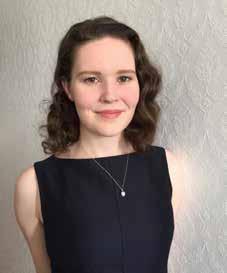
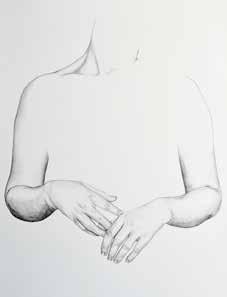
A multidisciplinary artist and graphic designer based in Hobart, Zoe Lovell studies the human form and how, through movement and body language, it is used as a tool to communicate. Zoe’s primary interest lies in portraiture, with her design practice providing services including identity and publication design. Tell us about your first solo exhibition. In October 2019 I presented my first solo exhibition, Conversations with the Human Form, at the Top Gallery in the Salamanca Arts Centre, while also working on a number of freelance design projects for local and interstate clients in drawings, paintings and ceramics. It was an exciting experience, having an exhibition of my own. My favourite piece from the exhibition, A Conversation ‘sequence’ is a large drawing featuring a sequence of hand gestures floating in space. What did you study at university? Following a Bachelor of Visual Communication in 2016 from the University of Tasmania, I completed a Bachelor of Fine Arts with First Class Honours in 2017. As part of this, I created five publications that observed the experiences of women in everyday life. In 2018, I was an artist in residence at the University of Tasmania, where I spent my time assisting the Head of Studio in the third-year Visual Communications class. In early 2019, I undertook my second residency at the Cradle Mountain Wilderness Gallery, focusing on the change in my environment during the weeklong stay. Since graduating from university, I’ve focused more on fine arts practice. Why did you choose this pathway? I was always drawn to and interested in art. It was my key focus and the way my brain works. I was also inspired by my parents, who are artists – my Mum is a sculptor and both my parents carve pieces for their artwork.
What do you hope to achieve professionally in the future? My aim for the future is to work on oil painting and build up a portfolio. I want to work towards getting an artist’s residence overseas, in Europe.
What is your advice for a current Year 12 student? You should definitely pursue art! The art community in Tasmania is really growing and encouraging new artists.
Staying in touch with OUR ALUMNI
MARJORIE FITZPATRICK 1920s
Alumni may recall that Marjorie Fitzpatrick has the honour of being our much-respected oldest past scholar of the College. She attended St Mary’s College in the 1920s and her story is recounted in 150 Faces of St Mary's College. Archbishop Emeritus Adrian Doyle is a regular visitor to Marjorie, through a family connection, and he reports that she celebrated her 105th birthday last November.
Marjorie continues to enjoy life in her sunny Launceston home, although she misses her outings and activities with friends in the current circumstances.
Marjorie is a living link to at least one of the original Sisters who came to Hobart from Fermoy, Ireland in 1866 to establish the College.
RACHAEL NOLAN CLASS OF 1997
Rachael Nolan was born in Hobart, the youngest of three siblings. Her elder brother Andrew and sister, Lucille, attended St Mary’s College before Rachael, who commenced in Prep in 1987. Lucille, who was a few years ahead of Rachael, finished Year 12 in 1996 and went on to complete a Fine Arts degree at RMIT in Melbourne.
Gerry Nolan, Rachael’s father, is well-remembered at the College as a strong supporter in all ways, particularly as a member of the Parents and Friends’ Association.
Although Rachael still has memories of some seemingly hard disciplinary ideals, she is quick to acknowledge that the education she enjoyed in both primary and secondary school set her up for life from a learning and academic point of view.
At the end of Year 10, Rachael’s father’s work took the family to Sale in Victoria, where Rachael was enrolled at Catholic College. Sadly, Gerry became seriously ill and the family lost their cherished father soon after.
With an ongoing interest in the Sciences, and particularly the environment, Rachael enrolled in the Environmental Science program at Melbourne’s Monash University. After four years of study, she completed her degree with Honours with a double major in Geography and Biology. After travelling for a while, Rachael took a position as an Environmental Consultant with a private consultancy, carrying out environmental impact assessments. Several years later, she applied for a scholarship to complete a PhD at Melbourne University. Her successful application led to a fouryear funded study and a very timely thesis on forests and bushfires, with a focus on the impact of the Victorian Black Saturday 2009 fires on Melbourne’s water catchments.
She remained in academia and decided to continue applied research. Her scholarly articles are widely published, and she is highly sought after for her opinions and comments, especially in the wake of Australia’s catastrophic summer bushfires of 2020.
For several years now, Rachael has worked from the Western Sydney University, through funding from the NSW Department of Planning, Industry and Environment.
St Mary’s College has every reason to be immensely proud of this ground-breaking young scientist, an inspiration to all of our own budding scientists.
